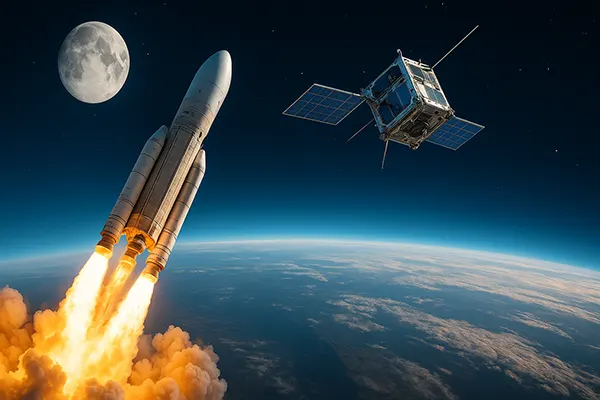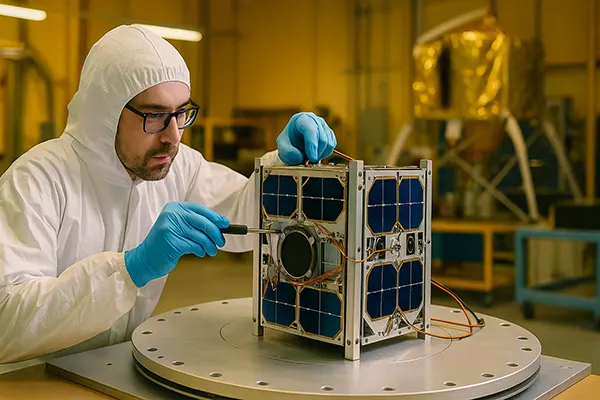
Microsatellites and Private Missions: How Startups Are Reshaping Space in 2025
In 2025, space is no longer the exclusive domain of government agencies and billion-dollar contractors. Microsatellites and private space missions have become powerful instruments of change, driven largely by ambitious startups. These ventures are not only lowering the cost of space access but are also accelerating innovation, transforming how we explore, monitor, and interact with the cosmos.
New Age of Microsatellites
Microsatellites—typically weighing less than 100 kg—have revolutionised the economics of satellite deployment. They are significantly cheaper to build and launch compared to traditional satellites, making them an attractive option for startups. As of February 2025, over 3,000 microsatellites are in orbit, with constellations providing services from broadband internet to Earth observation.
These compact satellites often use off-the-shelf electronics and modular architectures. Companies like Open Cosmos (UK), Astrocast (Switzerland), and Satellogic (Argentina) exemplify how microsatellites support applications in agriculture, climate monitoring, maritime tracking, and more. Their affordability and adaptability have enabled global coverage and near-real-time data collection.
Rideshare launches—where microsatellites hitch a ride on rockets alongside larger payloads—have further reduced costs. SpaceX, Rocket Lab, and India’s ISRO are among the most active enablers of such launches, providing frequent access to low Earth orbit (LEO) for small space tech firms.
Democratisation of Space Technology
Microsatellites have democratised access to space, empowering smaller nations, universities, and startups to conduct scientific and commercial missions. Projects that once required state-level funding can now be executed for under $1 million.
In 2025, university-led missions using CubeSats are common, providing hands-on space engineering experience to the next generation. These projects also serve vital purposes, such as climate change modelling and disaster response.
Private satellite networks are now a staple in global infrastructure. For instance, Finnish startup ICEYE’s SAR microsatellites deliver radar images in all weather conditions, day or night, and are used for insurance claims, ship tracking, and emergency response.
Private Missions Redefining Boundaries
Beyond Earth orbit, startups are pushing further. In 2025, commercial lunar and interplanetary missions are no longer futuristic dreams. Companies like Intuitive Machines, Astrobotic, and ispace are preparing or executing robotic landings on the Moon, many supported by NASA’s CLPS programme or ESA partnerships.
These missions aim not only for exploration but also resource prospecting. Lunar water-ice mining, in particular, has drawn commercial interest for its potential role in producing rocket fuel. Meanwhile, asteroid mining remains in early phases, with scouting missions planned by several stealth-mode startups.
The emergence of in-orbit servicing is another trend. Companies like Orbit Fab are developing refuelling depots in space, with the goal of enabling long-duration missions and sustainable satellite operations. As of early 2025, proof-of-concept missions have been successful, with first commercial services expected by 2026.
Shift from Government to Market-Driven Space
Government agencies now act more as customers or collaborators than sole operators. NASA and ESA increasingly contract startups for specific components or missions, allowing them to focus on scientific objectives while private partners handle development and logistics.
This shift fosters agility. Startups iterate faster, adopt risk-tolerant strategies, and bring consumer-style innovation to aerospace. For example, spacecraft from Firefly Aerospace and Blue Canyon Technologies are assembled in months—not years—thanks to lean manufacturing and software-driven design.
However, regulation and licensing still remain critical. In 2025, space traffic management is under scrutiny, and startups must navigate a growing web of national and international policies to ensure safe and responsible operations.

Challenges and Future Outlook
Despite remarkable progress, the rise of microsatellites and private missions is not without challenges. Space debris is a pressing issue, as thousands of new satellites increase the risk of collisions. The need for active debris removal and responsible end-of-life plans is urgent.
Funding is another obstacle. While VC investment in space tech remains strong, especially in the US and Europe, not all startups reach profitability. Delays in launch schedules, failed missions, or unclear revenue models can derail promising projects.
Nonetheless, the trajectory remains optimistic. With declining launch costs, expanding use cases, and maturing technologies, startups are expected to take an even more prominent role in shaping the future of space.
2025 and Beyond
In the coming years, we can expect tighter integration between microsatellites and AI-driven data platforms. This will enhance capabilities in sectors like agriculture, disaster mitigation, and autonomous transport.
Private space stations and orbital habitats are also on the horizon. Companies such as Vast and Axiom Space are already developing commercial modules to be launched by 2030. These could serve as research hubs, tourism outposts, or manufacturing facilities in microgravity.
Finally, international collaboration will play a critical role. Shared access to data, cooperative launches, and unified regulatory frameworks will be necessary to avoid fragmentation and ensure the long-term sustainability of near-Earth space activities.
